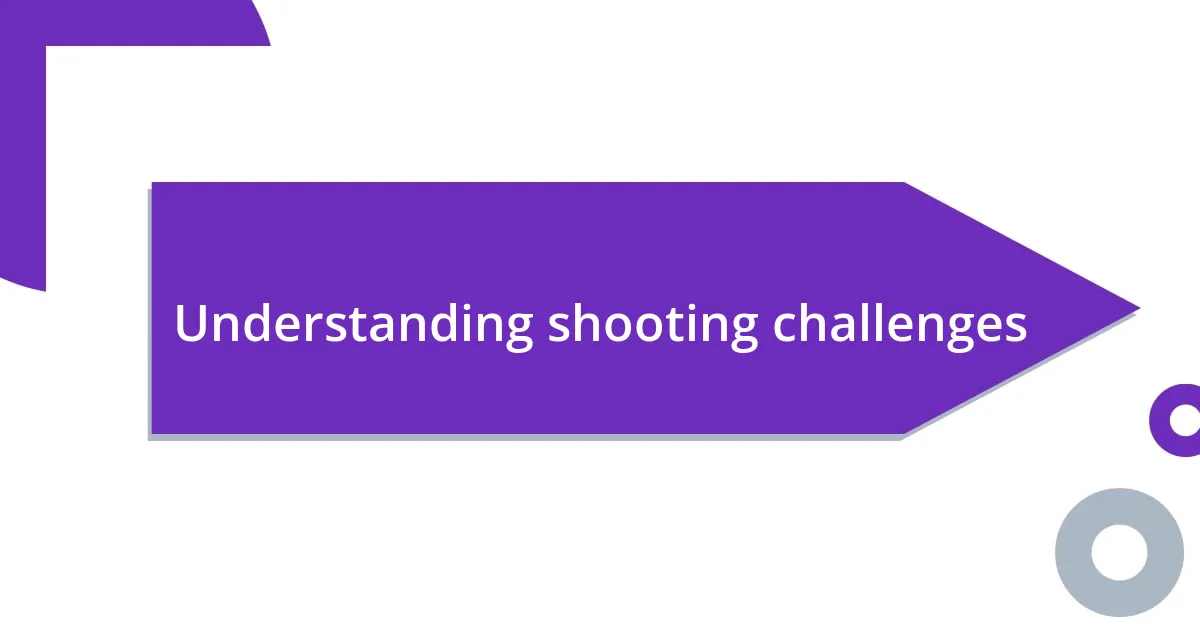Key takeaways:
- Embrace unexpected challenges by staying calm and fostering a flexible mindset, which can lead to creative solutions and new opportunities.
- Effective communication is crucial; regular check-ins and an open dialogue encourage collaboration and strengthen team trust.
- Reflecting on past experiences can guide future problem-solving and help avoid repeating mistakes, enhancing leadership skills.
- Sharing lessons learned from challenges fosters an environment of trust and growth, transforming setbacks into collaborative opportunities for improvement.

Understanding shooting challenges
Shooting challenges come in many forms, from unexpected weather changes to last-minute location issues. I remember a particular shoot where a sudden rainstorm forced us to scramble, leaving me feeling stressed yet invigorated as we raced to adapt our plans. Isn’t it interesting how these unpredictable moments can often lead to the most creative solutions?
Communication can also pose significant hurdles during shoots. There was a time when I misread a performer’s body language, thinking they were comfortable when, in fact, they were feeling pressured. This taught me the importance of being attuned to non-verbal cues—after all, isn’t a positive atmosphere essential for genuine creativity?
Then there are technical issues, which can feel like a filmmaker’s worst nightmare. I once encountered sudden equipment failure just minutes before a crucial scene—my heart raced. Yet, this situation reminded me to always have backups and to embrace the chaos; sometimes, those hiccups can push us to find innovative ways to achieve our vision. Have you ever had a tech failure that ended up sparking a unique creative idea?

Preparing for unexpected situations
One essential strategy I’ve developed for preparing for unexpected situations is to create a detailed contingency plan. For instance, during a challenging outdoor shoot, I learned to pack extra gear and alternative lighting options in case of unforeseen circumstances. This preparation not only gives me peace of mind, but it also keeps the team focused and energized, ready to pivot when issues arise. Have you ever found yourself wishing you’d packed that extra battery?
Another critical aspect is fostering a flexible mindset. I recall a shoot that took an unexpected turn when we discovered the chosen location had been double-booked. Instead of panicking, I encouraged my team to brainstorm nearby sites. This shift in attitude led us to stumble upon a breathtaking spot we hadn’t originally considered, turning what could have been a disaster into an extraordinary creative opportunity. Isn’t it fascinating how adaptability can transform a potential setback into a success?
Lastly, I emphasize the significance of thorough communication among the crew. During a past project, we faced a fractured communication flow that resulted in everyone working in different directions. I learned that implementing regular check-ins can significantly prevent this chaos. Now, before we start any shoot, I remind everyone about the importance of updates and shared responsibilities, ensuring we’re all on the same page—even amidst the unknown.
| Situation | Preparation Strategy |
|---|---|
| Weather Changes | Pack extra gear and options |
| Location Issues | Foster a flexible mindset |
| Communication Breakdowns | Implement regular check-ins |

Adapting to changing environments
Adapting to changing environments during shoots can be exhilarating, yet nerve-wracking. I remember a day when we were filming in a beautiful forest, and out of nowhere, the sun disappeared behind thick clouds. Instead of panicking, I quickly gathered my team and proposed we utilize the natural shadows to create a moody aesthetic. It was incredible to see everyone rally together, transforming what felt like a setback into an opportunity for artistic expression.
Here’s what I’ve learned helps in these situations:
- Stay Calm: Emotions can run high, but a composed leader inspires confidence.
- Re-evaluate on the Spot: Take a moment to assess the new environment and brainstorm creative solutions.
- Involve the Team: Encouraging input from team members can spark unique ideas you might not have considered.
- Experiment: Sometimes, embracing the unexpected can lead to those magic moments that set your project apart.
Recently, during another shoot, we faced strong winds that threatened to ruin our carefully set-up scene. I suggested a quick team huddle, where we all shared our thoughts on adjusting the camera angles to capture the swaying branches as a backdrop. It was amazing how we turned a potentially frustrating moment into a beautiful, dynamic shot that couldn’t have been planned. That experience reinforced my belief that adaptability isn’t just about reacting; it’s about finding joy in the unfolding journey.
- Maintain a Positive Attitude: Positivity can inspire a creative atmosphere.
- Cultivate Improv Skills: Being able to pivot quickly can lead to unexpected successes.
- Documentation: Keep notes of what works well in changing environments to reference for future projects.

Communicating with the team
When I think about the heart of a successful shoot, effective communication stands out as a cornerstone. On one occasion, we were shooting a high-energy dance sequence, and I noticed that the dancers weren’t syncing up well. I called everyone together for a quick circle where we discussed the vision and rhythm we were aiming for, and the energy in the room instantly transformed. Have you ever felt how just a few shared words can change the whole vibe?
I find that encouraging an open dialogue not only fosters creativity but also strengthens trust within the team. During one shoot, a crew member hesitated to voice concerns about the equipment setup. When I noticed their discomfort, I made it a point to create a safe space for feedback. After a brief discussion, we adjusted the setup, which ultimately led to smoother filming and a more cohesive final product. Isn’t it fascinating how one conversation can unveil solutions right before our eyes?
To keep the lines of communication flowing, I always incorporate regular check-ins throughout the shoot. For instance, during a recent project, I initiated quick mid-shoot huddles, where everyone shared updates on their tasks. This practice not only sharpened our focus but also highlighted areas where we could collaborate more effectively. Reflecting on this, I realized that communication isn’t just about speaking; it’s about listening and responding with intention. How do you keep communication on your set active and engaging?

Tools for problem-solving
When it comes to problem-solving on set, having the right tools is essential. One that I deeply value is the ability to quickly switch gears. I remember a shoot where we faced unexpected technical difficulties with our lighting setup. Instead of letting the frustration fester, I grabbed a portable LED light and encouraged the team to brainstorm how we could use that as a primary light source. It turned out to be a game changer, creating a beautiful, soft glow that enhanced our shots. Have you ever found that something as simple as a different light can transform your entire vision?
Another crucial tool in my problem-solving toolkit is a solid backup plan. Early in my career, I learned the hard way that not everything goes according to plan. During one project, our main location fell through at the last minute. While it was disheartening, I flicked through my mental catalog of alternative locations and quickly pitched a nearby rooftop that had stunning views. The team rallied behind the idea, and we ended up capturing some of the most breathtaking shots I’ve ever taken. It made me realize the importance of thinking ahead and being ready to pivot in an instant.
Lastly, I can’t stress enough the value of technology in aiding our problem-solving efforts. There are countless apps out there for managing shot lists and schedules, but one that has drastically improved my workflow is a collaborative project management tool. I’ve used it on various shoots to track progress and address potential issues in real-time. During a recent film, we had an unexpected change in the weather forecast. Thanks to our proactive approach through the app, we quickly rearranged our schedule, allowing us to achieve everything we aimed for. It’s impressive how technology can streamline our communication and decision-making process. Have you explored the possibilities that tech tools can bring to your shoots?

Reflecting on past experiences
Reflecting on past experiences often reveals patterns that can help navigate future challenges. I vividly recall a shoot where we battled a chaotic schedule. Tensions ran high, and I found myself questioning whether we would achieve our goals. In that moment of doubt, I remembered a previous project that also felt overwhelming at first. Drawing on that experience, I gathered the team and we re-evaluated our priorities, ultimately creating a timeline that felt more manageable. It was a lesson in resilience—how looking back can sometimes shed light on the way forward.
There are times when reflecting on setbacks allows us to grow. During one production, we faced issues with the talent’s emotional delivery, which I hadn’t foreseen. As I debriefed myself later, I recalled a shoot where a similar moment had flourished once I took the time to connect with the actor on a personal level. This inspired me to step in gently, discussing their character’s backstory, which opened a well of emotion we successfully tapped into. Have you ever noticed how revisiting past hurdles can unveil solutions in unexpected places?
I’ve also realized that self-reflection strengthens leadership skills. At one point, I experienced a miscommunication that led to a missed scene. Even though it was frustrating, reflecting on that moment reinforced the importance of clarity. I took this experience to heart and established clearer visual cues for the crew. Not only did it prevent future mix-ups, but it also created a culture where everyone felt more confident in asking questions. Isn’t it amazing how our past can steer our choices and nurture growth as we move forward?

Sharing lessons learned
Sharing lessons learned can often reveal invaluable insights that shape our future endeavors. I remember a particularly challenging shoot that tested my patience. The weather didn’t cooperate, and with tight timelines, anxiety in the crew started to rise. Instead of letting the tense atmosphere linger, I decided to share an experience from my past where we thrived despite adverse conditions. That moment allowed me to shift the team’s focus from frustration to creativity, and together, we transformed the rain into a beautiful visual element.
During another project, miscommunication almost derailed us, and I felt a surge of disappointment as we missed a crucial shot. Reflecting on that incident helped me realize how vital clear communication channels are on set. I then took the initiative to implement daily briefings, which not only streamlined operations but also fostered a sense of unity among the team. Have you ever had a moment where you wished you could rewind and tackle a situation differently? I assure you, establishing open dialogue can make all the difference.
Most importantly, I’ve learned that vulnerability can be a strength. After a particularly difficult shoot, I gathered everyone for a wrap-up discussion. I opened up about my challenges and invited the crew to share theirs too. This exchange created a powerful environment of trust, where we all learned from each other’s experiences. It reminded me that every challenge is an opportunity for growth if we’re willing to embrace it. How often do you take the time to reflect on your journey and share those lessons with others? The connections forged through shared experiences can lead to incredible transformations.














